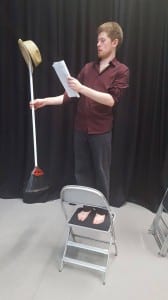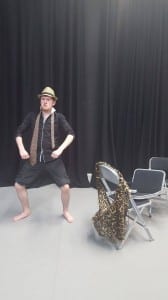Rehearsing for Meta! was fairly simple as for the most part it was simply planning the content I wanted for the show, then also working out what set and props I required. When forming the content I planned to perform the show as a structured improvisation, so I would know a set order for the show, and roughly what required saying at each point. I settled on this because it would give the impression of authenticity to the ‘pre-show’ section of the performance, rather than give it a potentially rigid or structured feel to it. For a considerable length of time I was uncertain which topics to mention and address within the show, with examples of these being allergy warnings, fire alarm warnings and profanity warnings. I wanted to strike a balance between coddling the audience with warnings and catering to their whims, whilst also establishing a large number of elements that are present in contemporary theatre culture, but are almost entirely superfluous. Taking inspiration from Will Eno’s Tom Paine based on nothing I really wanted to establish a relationship to the audience. Whilst not to the same extent as in Tom Paine planned to immediate speak to the audience in the performance, to immediately establish that I was speaking directly to them as audience members.
One element however that was necessary to the show as a whole was to make sure it flowed from one topic to the next, and felt authentic. If the performance felt as if it was rigidly following a script then it would lose some of its impact. To this end I have recorded a improvised version of the show, with a rough structure planned out beforehand so that I have a rough idea of the direction and to give me a sense of how long the show will take. Once I had a number of topics I create a list of potential post-show discussion questions that I could give to planted audience members. Whilst some were simple I decided to have some that were a reflection of the show that Meta! purported to be. These were the questions that linked well to explaining metaphors and seeking approval from me as a the creator of performance. However I was unsure of how many I might need due to the timing of the performance, so I will narrow down the list later down in the process, and also I can later make some of the questions relate somewhat to the set I eventually decide upon.

Another ‘rehearsal’ picture to give the impression I was still in the process of learning lines, and that there was a full script.
In order to create the illusion that the show was progressing, and to further wrong-foot the audience I created a number of staged ‘rehearsal’ photos. By posting these to the various social media sites for Meta! I hoped to create anticipation for a performance that didn’t actually exist. I choose pictures that fitted with the theme of the initial profile picture in order to create the impression of a slightly zany show that should be amusing to watch. Later on in the process I even went to the extent to acquire a fake quotation from my tutor concerning the performance, “It’s such a relief to see a show that’s uplifting after years of turgid crap. I blame Sarah Kane.” (Pulford, 2016) This combined with my initial description of the performance on social media of
“Meta! is a solo performance by Simon Payne. Addressing both timeless and contemporary topics, it is an artistic take on real life, adventurous and moving.”
sought to create the idea that Meta! was a fully fleshed out and serious performance. Hopefully all these elements with work together to create the impression of a performance for the audience that can be completely shattered and satirised once the performance actually begins.
